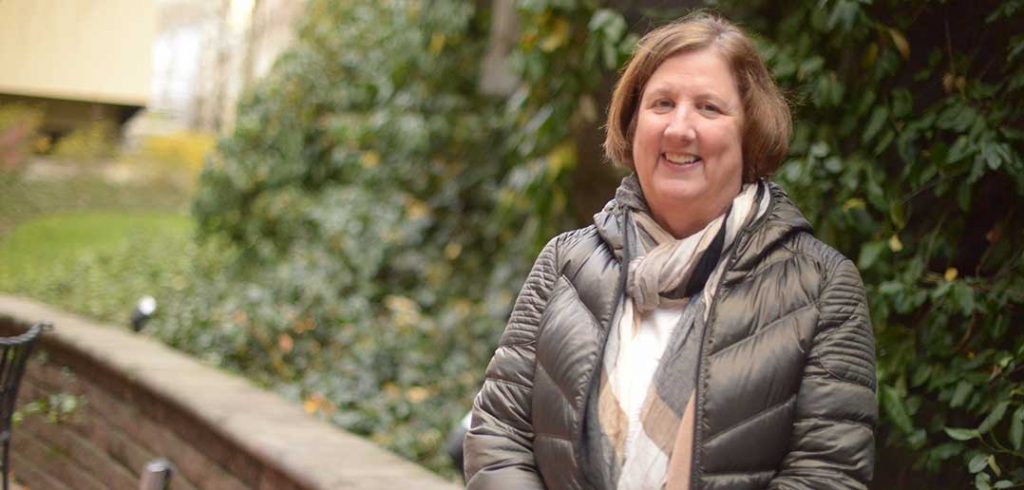If you want to treat children suffering from trauma, it’s not enough to teach clinical social workers the best evidence-based treatments. You also need to prime a whole ecosystem of care so it can embrace change.
This is the challenge that Virginia Strand, D.S.W., co-director of the Graduate School of Social Service’s (GSS) National Center for Social Work Trauma Education and Workforce Development (the Center), has accepted.
In 2012, the center received a $2.4 million grant from the Substance Abuse and Mental Health Services Administration (SAMHSA) to pursue an ambitious multipronged education program aimed at changing the way social workers treat children, adolescents and their families suffering from trauma.
Four years later, Strand said she’s happy with how her staff both introduced a new trauma-related curriculum and helped agencies provide field instruction to social work students in the evidence-based trauma treatments.
The Center recruited 65 schools of social work to teach a course that Center faculty developed on trauma to nearly 5,000 students. Data from evaluation surveys they took afterward were encouraging.
“We were able to see that in fact, students emerged feeling much more confident about their knowledge and ability to intervene with traumatized children and their families. It was exciting that we were able to disseminate this so broadly and have it be successful,” she said.
The Center also trained the faculty of six schools of social work (and one partner agency at each) in how to implement evidence-based trauma treatments. The schools used an implementation science framework to help a partner agency implement evidence-based trauma treatments.
The challenge going forward will be locating funds for the necessary training.
“Most evidence-based treatment developers will tell you that it takes both a two-day orientation, plus six to 12 months of weekly to biweekly consultation calls to really learn a model,” she said. “It’s very difficult for agencies to free up staff and get funds for that training time.”
Money is likewise an issue when it comes to treatment. Evidence-based treatments for children recovering from sexual abuse and domestic violence often require activities that are not yet reimbursable by insurance.
“Clinicians may need more than one-on-one sessions with the child; they may also need sessions that include parents or other family members, because they’re trying to implement a particular model,” Strand said.
Part of that model is recognizing that children who grow up with chronic exposure to abuse and neglect have difficulty forming attachments in adult life. They can then become socially isolated, and become trapped in a vicious cycle.
Strand said new treatments have emerged in part because researchers have a better understanding of how long-term exposure to trauma alters the development of a child’s brain. Studies have shown, for instance, that children who’ve been abused and neglected have a smaller than normal hippocampus, an area of the brain that helps store and categorize memories. This makes it harder to concentrate and memorize, so they do poorly in school.
“New information about how the brain is affected by trauma has helped people understand how serious the impact is, why it’s critical to intervene, and why it’s so important to use these trauma treatments,” Strand said.
Another challenge that trauma victims face is continued stimulation of the midbrain, via their “fight, flight or freeze” responses to traumatic events. Cortisol levels that would normally decrease after stressful events have passed instead stay at high levels, making them more reactive to eventsin the current environment.
“A lot of behavior that we see with adolescents who seem to be out of control has to do with being triggered by something in the current environment that pushes them into the past, and they’re reacting out of their past emotional experience, not in response to what’s in the present,” Strand said.
“People who aren’t trained in trauma just see kids who are bad.”
The SAMHSA grant ends in October 2017. Going forward, Strand wants to explore the field of implementation science more fully.
“After a point, you know something is working because you’ve done enough research,” she said. “The real challenge is, how do you move it into community practice? It’s one thing to be well funded, and work in whatever “lab” or community setting they’re tested in,” she said.
“But how do you generalize that? How do you get that best practice to be used more broadly? That was a big part of what we’ve begun to do.”

